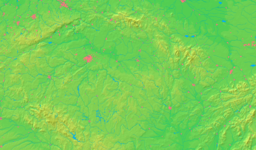- Dubí
-
Dubí Town Church of Immaculate ConceptionFlagCoat of armsName origin: place of oaks / oak forest Country Czech Republic Region Ústí nad Labem District Teplice Commune Teplice Elevation 389 m (1,276 ft) Coordinates 50°40′44″N 13°47′27″E / 50.67889°N 13.79083°E Area 33.85 km2 (13.07 sq mi) Population 8,086 (2006-08-28) Density 239 / km2 (619 / sq mi) First mentioned 1494 Mayor Petr Pípal (ODS) Timezone CET (UTC+1) - summer (DST) CEST (UTC+2) Postal code 417 01 - 417 32 Wikimedia Commons: Dubí Statistics: statnisprava.cz Website: www.mesto-dubi.cz Dubí (Czech pronunciation: [ˈdubiː]; German: Eichwald) is a town in the Ústí nad Labem Region, in the Czech Republic, near Teplice in the Ore Mountains, with 7,792 residents. It is an important transit point to Germany on European route E55, and the border crossing Cínovec is located within the town limits. There is a spa with mineral waters and a china factory there. The railroad line (Most -) Dubí - Moldava v Krušných horách, that passes through the town, was declared a national monument in 1998. After the Velvet Revolution, the town received bad publicity due to rampant prostitution, fueled by the close proximity to Germany, location on a main truck route and low purchasing power in the Czech Republic; municipal authorities have been struggling with this issue with some recent successes.[1][2]
Contents
History
Dubí was first mentioned in the period of 1494 - 1498 as a village of tin miners (in Czech cín, giving the name to nearby Cínovec). Rapid development started in the 19th century. First, a new road to Saxony was built, followed by a spa (1862) and a railroad (1884). Dubí has become a popular holiday resort, visited by Johann Wolfgang Goethe, Jan Neruda, Václav Talich and others. its land is very rich.
Sights and spa
The most important sight in Dubí is Saint Maria's Church, which was built on the order of princes Clary-Aldringen between 1898 and 1906 as a copy of the Venice church Santa Maria dell'Orto to serve as their family's church.
The first spas in Dubí were built in 1860 under the management of Anton Tschinkel, the founder of a local china factory. In 1862, his first spa (Diana Spa) was opened. The present-day Theresa Spa (Tereziny lázně) with mineral waters, recommended to patients after brain and spine surgeries, have been operating since 1879.
The scenic railroad line Dubí - Moldava was declared a national monument in 1998.
Gallery
References
- Municipal website (Czech)
- Old foto 1880-2000 (Czech)
- Railroad Dubí - Moldava and its timetable (Czech)
- Theresa's Spa in Dubí (English)
Footnotes
- ^ Dan Bilefsky, Financial Crisis Tames Demand for World’s Oldest Service, New York Times, December 8, 2008.
- ^ Stastna, Kazi. "Taxing the Professionals". Central Europe Review. http://pecina.cz/files/www.ce-review.org/99/22/stastna22.html. Retrieved 2009-10-17.
Towns, market towns and villages of Teplice District Bílina · Bořislav · Bystřany · Bžany · Dubí · Duchcov · Háj u Duchcova · Hostomice · Hrob · Hrobčice · Jeníkov · Kladruby · Kostomlaty pod Milešovkou · Košťany · Krupka · Lahošť · Ledvice · Lukov · Měrunice · Mikulov · Modlany · Moldava · Novosedlice · Ohníč · Osek · Proboštov · Rtyně nad Bílinou · Srbice · Světec · Teplice · Újezdeček · Zabrušany · Žalany · Žim
This Ústí nad Labem Region location article is a stub. You can help Wikipedia by expanding it.







